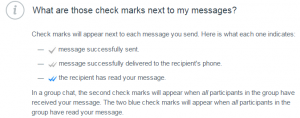Today, in my digital newspaper I read about a bit of uproar regarding WhatsApp. Apparently WhatsApp has changed their indications of message delivery. Previously, they did not provide any information whether a message was read, and now they do. What is interesting from a user-centered innovation point of view, is this change in functionality and users’ responses. See the screenshot with WhatsApp’s explanation of message delivery status.
Acknowledgement. With this indication, you as the sender of a message can now determine whether your contact (i.e., the human recipient) has not only received the message on their device, but also actually read your message. In computer science communication, network or transaction protocols, this is called an acknowledgement message. If you know the other party has successfully received the information, then the other party is (likely) to perform its other actions as described by the protocol. In email programs this acknowledgement is called a ‘read receipt’. Email programs offer you the option to send, or not send, such a read receipt.. Other communication programs also offer read-receipts, and their users adopted their use.
So what is the uproar about? Quickly analysed by reading a number of posts and articles, it boils down to (a) privacy and (b) autonomy. Let’s look at both.
Privacy. It is now possible for the sender of the message to inspect at what time the recipient did read the message. And yes, this publishes information that previously was private. As an aside, note that when calling on the phone to someone and hearing their background noise, you also gain information about their context and you know whether they answered, or ignored, your call. Returning to WhatsApp: it now may become possible to track someone’s WhatsApp-behaviour by correlating message-reading times. This may have impact on people who use WhatsApp at work. We’ll have to see what happens when a boss checks the speed of WhatsApp responses of his employees… Perhaps it is wise to have more imprecise reading-times (e.g., “in the last two hours”, “yesterday”) that would mitigate some of the privacy concerns while still conveying some information. Or better: make a setting that me as the user can state whom should know when with what precision I’ve read messages.
For now, I would be cautious and resist the urge to respond immediately to WhatsApp messages if you are at work (and the messages are not related to work, obviously). Which is easily said for me, as I use WhatsApp solely for coordination information regarding my children’s sport activities.
Autonomy. Users feel obliged to swiftly respond: If it is known to the sender when the message is read by me, then I should also respond in a timely fashion. Interesting enough, it is not the software itselfs that changes the (perception of) autonomy of the users, rather, it is peer-pressure. And this is an issue that has been present with all communication technologies (postal mail, email, sms, phone call, chat, Whatsapp, Skype, …). Humans are not machines – and often humans do not work according to strict protocols. Which implies that expecting that your contacts have certain performance characteristics regarding frequency of monitoring WhatsApp and responding in a timely fashion is really an expectation.
My opinion? If I choose not to respond immediately to an incoming message, I have my reasons for it. The sender should trust my ability to decide on priorities. If the sender must have a timely response: either (a) indicate this in the message, or (b) use a more direct method of communication, such as calling me on the phone.
From a user-centered innovation point of view, WhatsApp apparently changed a delivered added-value (i.e., added read-receipt) without first checking the desired-added value of their users. Do the users want, or not want, read-receipts? What kind of control is desired by users? It will be interesting to see how this story unfolds.
A non-exhaustive list of information about WhatsApp and the two blue ticks:
- Dutch newspapers Volkskrant article (2014-07-11) on ‘Twee Blauwe Vinkjes’
- English article from BBC about the meaning of the two blue ticks (2014-11-06)
- WhatsApp Dutch and English FAQ about the two blue ticks.
- About acknowledgements in communication protocols for computer networks on Wikipedia.
- Description of peer pressure on Wikipedia
- About peer-pressure to immediately respond a blog by Sanna Chu on iDigitalTimes.





